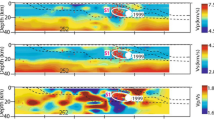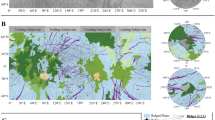Abstract
A high-resolution marine geophysical study was conducted during October-November 2006 in the northern Gulf of Aqaba/Eilat, providing the first multibeam imaging of the seafloor across the entire gulf head spanning both Israeli and Jordanian territorial waters. Analyses of the seafloor morphology show that the gulf head can be subdivided into the Eilat and Aqaba subbasins separated by the north-south-trending Ayla high. The Aqaba submarine basin appears starved of sediment supply, apparently causing erosion and a landward retreat of the shelf edge. Along the eastern border of this subbasin, the shelf is largely absent and its margin is influenced by the Aqaba Fault zone that forms a steep slope partially covered by sedimentary fan deltas from the adjacent ephemeral drainages. The Eilat subbasin, west of the Ayla high, receives a large amount of sediment derived from the extensive drainage basins of the Arava Valley (Wadi ’Arabah) and Yutim River to the north–northeast. These sediments and those entering from canyons on the south-western border of this subbasin are transported to the deep basin by turbidity currents and gravity slides, forming the Arava submarine fan. Large detached blocks and collapsed walls of submarine canyons and the western gulf margin indicate that mass wasting may be triggered by seismic activity. Seafloor lineaments defined by slope gradient analyses suggest that the Eilat Canyon and the boundaries of the Ayla high align along north- to northwest-striking fault systems—the Evrona Fault zone to the west and the Ayla Fault zone to the east. The shelf–slope break that lies along the 100 m isobath in the Eilat subbasin, and shallower (70–80 m isobaths) in the Aqaba subbasin, is offset by approx. 150 m along the eastern edge of the Ayla high. This offset might be the result of horizontal and vertical movements along what we call the Ayla Fault on the east side of the structure. Remnants of two marine terraces at 100 m and approx. 150 m water depths line the southwest margin of the gulf. These terraces are truncated by faulting along their northern end. Fossil coral reefs, which have a similar morphological appearance to the present-day, basin margin reefs, crop out along these deeper submarine terraces and along the shelf–slope break. One fossil reef is exposed on the shelf across the Ayla high at about 60–63 m water depth but is either covered or eroded in the adjacent subbasins. The offshore extension of the Evrona Fault offsets a fossil reef along the shelf and extends south of the canyon to linear fractures on the deep basin floor.








Similar content being viewed by others
References
Arz HW, Lamy F, Pätzold J, Müller PJ (2003) Mediterranean moisture source for an Early-Holocene humid period in the Northern Red Sea. Science 300:118–121. doi:10.1126/science.1080325
Ben-Avraham Z (1985) Structural framework of the Gulf of Eilat (Aqaba), Northern Red Sea. J Geophys Res 90:703–726
Ben-Avraham Z, Garfunkel Z (1986) Character of transverse faults in the Eilat-pull-apart basin. Tectonics 5:1161–1169
Ben-Avraham Z, Tibor G (1993) The northern edge of the Gulf of Eilat. Tectonophysics 226:319–331
Ben-Avraham Z, Almagor G, Garfunkel Z (1979) Sediments and structure of the gulf of Eilat (Aqaba)—Northern Red Sea. Sediment Geol 23:239–267
Ehrhardt A, Hubscher C, Ben-Avraham Z, Gajewski D (2005) Seismic study of pullapart-induced sedimentation and deformation in the Northern Gulf of Aqaba (Eilat). Tectonophysics 396(1/2):59–79
Fonseca L, Calder BC (2006) Geocoder: an efficient backscatter map constructor. Center for Coastal and Ocean Mapping, University of New Hampshire, Durham, NH. www.thsoa.org/hy05/08_3.pdf
Fricke HW, Landmann G (1983) On the origin of Red Sea submarine canyons, observations by submersible. Naturwissenschaften 70:195–197
Garfunkel Z (1981) Internal structure of the Dead Sea leaky transform (rift) in relation to plate kinematics. Tectonophysics 80:81–108
Garfunkel Z, Eyal Y, Eyal M, Weussbord T, Bakler N, Shimron AE, Peltz S, Gutkin V, Bartov Y, Druckman Y, Rosensaft M, Sneh A (2000) Geological map of the northern Gulf of Elat area. Scale 1:100,000, Sheet 26 Elat. Geological Survey of Israel, Jerusalem
Ginat H, Enzel Y, Avni Y (1998) Translocated Plio-Pleistocene drainage systems along the Arava fault of the Dead Sea transform. Tectonophysics 284(1/2):151–160
Gvirtzman G (1994) Fluctuations of sea level during the past 400 000 years: the record of Sinai, Egypt (northern Red Sea). Coral Reefs 13(4):203–214
Haberland Ch, Maercklin N, Kesten D, Ryberg T, Janssen Ch, Agnon A, Weber M, Schilze A, Qabbani I, El-Kelani R (2007) Shallow architecture of the Wadi Araba fault (Dead Sea Transform) from high-resolution seismic investigations. Tectonophysics 432(1/4):37–50
Hall JK, Ben-Avraham Z (1978) Bathymetric chart of the Gulf of Elat. Scale 1:250,000, contour interval 50 m. Geological Survey of Israel, Jerusalem
Klinger Y, Rivera L, Haessler H, Maurin JC (1999) Active faulting in the Gulf of Aqaba: new knowledge from the Mw7.3 earthquake of 22 November 1995. Bull Seismol Soc Am 89:1025–1036
Klinger Y, Avouac JP, Abou Karaki N, Dorbath L, Bourles D, Reyss JL (2000a) Slip rate on the Dead Sea transform fault in northern Araba valley (Jordan). Geophys J Int 142(3):755–768
Klinger Y, Avouac JP, Dorbath L, Karaki NA, Tisnerat N (2000b) Seismic behaviour of the Dead Sea fault along Araba valley, Jordan. Geophys J Int 142:769–782
Mackenzie KV (1981) Discussion of sea-water sound-speed determinations. J Acoustical Soc Am 70(3):801–806
Makovsky Y, Wunch A, Ariely R, Shaked Y, Rivlin A, Shemesh A, Ben Avraham Z, Agnon A (2008) Quaternary transform kinematics constrained by sequence stratigraphy and submerged coastline features: the Gulf of Aqaba. EPSL 271:109–122
Niemi TM, Smith AM II (1999) Initial results of the southeastern Wadi Araba, Jordan geoarchaeological study: implications for shifts in Late Quaternary aridity. Geoarchaeology 14(8):791–820
Niemi TM, Zhang HW, Atallah M, Harrison JBJ (2001) Late Pleistocene and Holocene slip rate of the Northern Wadi Araba fault, Dead Sea Transform, Jordan. J Seismol 5(3):449–474
Reches Z, Erez J, Garfunkel Z (1987) Sedimentary and tectonic features in the northwestern Gulf of Eilat, Israel. Tectonophysics 141:169–180
Sade A, Hall JK, Tibor G, Niemi TM, Ben-Avraham Z, Al-Zoubi AA, Hartman G, Akawwi E, Abueladas A, Amit G (2008) The Israel national bathymetric survey: Northern Gulf of Aqaba/Elat. Israel J Earth Sci 57:139–144
Shaked Y, Agnon A, Lazar B, Marco S, Avner U, Stein M (2004) Large earthquakes kill coral reefs at the north-west Gulf of Aqaba. Terra Nova 16:133–138. doi:10.1111/j.1365-3121.2004.00541.x
Siddall M, Rohling EJ, Almogi-Labin A, Hemleben C, Meischner D, Schmelzer I, Smeed DA (2003) Sea-level fluctuations during the last glacial cycle. Nature 423:853–858
Siddall M, Smeed DA, Hemleben C, Rohling EJ, Schmelzer I, Peltier WR (2004) Understanding the Red Sea response to sea level. Earth Planet Sci Lett 225:421–434
ten Brink US, Rybakov M, Al-Zoubi AS, Rotstein Y (2007) Magnetic character of a large continental transform: an aeromagnetic survey of the Dead Sea Fault. Geochem Geophys Geosyst 8(8):1–13
Zak I, Freund R (1966) Recent strike-slip movements along the Dead Sea rift. Israel J Earth Sci 15:33–37
Acknowledgements
We thank the crews of the R/V Etziona and Danny boy, and the Jordanian navy and Israeli navy for helping and coordinating the marine survey. This survey was funded by MERC grant TA-MOU-05-M25-004 and the Margaret Kendrick Blodgett Foundation. We thank Uri ten Brink and Monique T. Delafontaine for reviewing this paper and providing helpful comments.
Author information
Authors and Affiliations
Corresponding author
Rights and permissions
About this article
Cite this article
Tibor, G., Niemi, T.M., Ben-Avraham, Z. et al. Active tectonic morphology and submarine deformation of the northern Gulf of Eilat/Aqaba from analyses of multibeam data. Geo-Mar Lett 30, 561–573 (2010). https://doi.org/10.1007/s00367-010-0194-y
Received:
Accepted:
Published:
Issue Date:
DOI: https://doi.org/10.1007/s00367-010-0194-y




